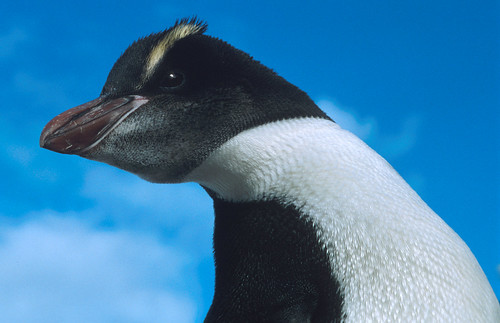
Facts
Kingdom Animalia
Phylum Chordata
Class Aves
Order Sphenisciformes
Family Spheniscidae
Genus Eudyptes (1)
Size Height: 60 cm (2)
Weight 4 kg (3)
Status
Classified as Endangered (EN) on the IUCN Red List 2006 (1).
Description
Erect-crested penguins are perhaps some of the most mysterious of all penguin species (4). This species is one of the largest of the crested penguins and shares with the Fiordland and Snares crested penguins the distinctive feature of an upward-sweeping crest of long, yellow brush-like feathers above each eye, extending from the base of the bill to the top of the head (4) (5). Unlike other crested penguins, however, the erect-crested penguin is able to raise and lower these stiff crest feathers (4). With its black back and white belly, this species sports the classic penguin ‘tuxedo look'. The upper sides of the wings are black with a white edge and the lower sides are white with a black patch at the tip. Males are generally larger than females, and both sexes have long, slender beaks that are dark brown-orange in colour (3).
Range
The majority of the breeding population occurs on the Bounty and Antipodes Islands, with smaller numbers on the Auckland and Campbell Islands, New Zealand. The non-breeding winter distribution is spent at sea in the sub-Antarctic oceans, although the exact location is unknown (6).
Habitat
Nests are constructed in large, dense colonies on rocky terrain, often without substantial soil or vegetation, up to 75 m above sea level (2).
Biology
The erect-crested penguin is an extremely social bird that breeds in large, raucous colonies of several thousand pairs, usually alongside rockhopper penguins (Eudyptes chrysocome) (4) (6). This species uses a number of displays and vocalisations, utilised particularly in the courtship and breeding season and in aggressive territorial behaviour during mate matching or when defending nesting sites (3) (6). Courtship displays include an enthusiastic greeting with an open bill, vertical head swinging, trumpeting, quivering, bowing and preening (3). Aggressive displays include use of the crests, growling and barking, while direct fighting involves twisting of locked bills or biting of the enemy on the neck while beating them with the flipper (3) (6).
Males usually return to the breeding site in September, and compete fiercely for prime nesting sites (6) (7). The females join the males two weeks later and work together to construct nests made of mud, stones and grass (3). Two eggs are laid in early October, although the first egg, which is noticeably smaller than the second, is usually lost (4) (6). The second egg is up to twice as large as the first, and is the only one seriously incubated (5). The male and female take turns incubating the egg for about 35 days (3) (6). After hatching, the chicks are fed regurgitated food by the female until they fledge in February. For three to four weeks the male stands guard without food while the female forages and returns daily to feed the chick (3) (6). Adults return to the sea for the (austral) winter after moulting in March (3) (7).
Little is known about the feeding habits of the erect-crested penguin, but the main sources of food are thought to be krill and squid, occasionally supplemented by small fish (2) (6).
Threats
Although still fairly abundant, the erect-crested penguin is considered endangered because it is thought to have undergone significant declines of at least 50% over the last 45 years, a pattern that is only expected to continue. Furthermore, the species' very small and restricted breeding range leaves it particularly vulnerable (2). The reasons for this decline are not fully understood, but are believed to be associated with marine factors, as predation on land during the breeding season is unlikely to be significant, since there are no mammalian predators on the Bounty or Antipodes Islands, except for mice on the main Antipodes Island (2) (7).
Conservation
All the islands on which the erect-crested penguin is found are nature reserves and, as of 1998, became part a World Heritage site. Cattle and sheep were eradicated from Campbell Island in 1984 and 1992 respectively, and introduced brown rats (Rattus norvegicus) have also been successfully removed from Campbell Island (2).
Further Information
For more information on the erect-crested penguin see:
* International Penguin Conservation Working Group (IPCWG):
http://www.penguins.cl/erect-penguins.htm
* New Zealand Penguins:
http://www.penguin.net.nz/species/ecp/index.html
References
1. IUCN Red List (September, 2006)
http://www.iucnredlist.org
2. BirdLife International (November, 2006)
http://www.birdlife.org/datazone/species/index.html?action=SpcHTMDetails.asp&sid=3856&m=0
3. MarineBio (November, 2006)
http://marinebio.org/species.asp?id=648
4. Antarctic Connection (November, 2006)
http://www.antarcticconnection.com/antarctic/wildlife/penguins/erect_crested.shtml
5. New Zealand Penguins (November, 2006)
http://www.penguin.net.nz/species/ecp/index.html
6. Animal Diversity Web (November, 2006)
http://animaldiversity.ummz.umich.edu/site/accounts/information/Eudyptes_sclateri.html
7. International Penguin Conservation Work Group (IPCWG) (November, 2006)
http://www.penguins.cl/erect-penguins.htm
Fact sheet courtesy of Archive @
http://www.arkive.org/erect-crested-penguin/eudyptes-sclateri/info.html
Image credit: Dandyfine @ Flickr

















No comments:
Post a Comment